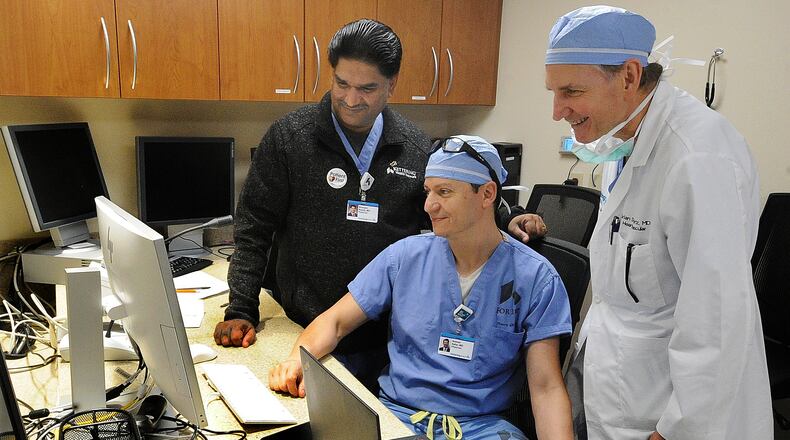“AI is coming into health care in every possible way,” said Dr. Niranjan Reddy, chief of interventional cardiology for Kettering Health. “Kettering has gone with the new approach of using AI to improve their processes to get best outcomes.”
If a patient had a complication or negative outcome following a procedure, doctors used to analyze that patient data about every three months after the fact, said Dan Halvorsen, integration manager of care pathways at Terumo.
“We used to look retrospectively and say, ‘What could we have done differently?’” Halvorsen said. “And that’s great, it helps you to improve. But now, with technology like artificial intelligence, we don’t have to wait until three months after the patient has left to look at their data. In fact, we can look at it before we treat them.”
Doctors can determine patient risk factors based on the data and demographics they input in to the software, helping doctors decide the best path forward for the patient, depending on their potential risks.
“We can look at their data when we’re interviewing them in the clinic, and we can decide how to move forward in a way that will reduce unwanted outcomes,” Halvorsen said. “It will allow the patient to get discharged sooner, and also we can educate the patient on exactly why we’re doing what we’re doing and show them their specific, personalized story.”
The software does not tell the doctors what to do, but it provides them a risk assessment on if patients may be prone to experience a negative outcome, Reddy said.
Some of the other ways doctors are using predictive software at area hospitals is in diagnostics, determining if patients have a certain disease or cancer, or are at risk for one, based on certain demographics like patient and family history, said Dr. Albert Bonnema, Kettering Health’s chief medical information officer. From that, doctors are also using technology to determine which treatments patients may respond to best.
“We’re using software to be able to choose the right therapy,” Bonnema said.
Another area is in prognosis prediction, Bonnema said, where technology can help doctors determine what the course of a disease will look like in a specific patient. Such as for cancer, it can help the patient and their doctors determine whether to do radiation or surgery depending on where the patient is in the course of their illness and how the patient may respond to each of those treatments.
Doctors are using predictive algorithms to determine if patients may be at risk for falls, or at risk for being readmitted to the hospital soon after being discharged, which would help doctors and nurses know if a patient needs extra care while in the hospital.
“It’s quite a complex aggregation of data,” Bonnema said. The data can include a patient’s vital signs, like their body temperature, pulse, and blood pressure, as well as other factors like age, prior procedures, and family history.
Local hospitals are also using AI to determine if patients are at risk of developing sepsis, a severe infection that can be life-threatening.
“We have a sepsis detection algorithm running in the system that looks for patients who might be heading down a path of becoming septic,” said Dr. Walter Reiling, Premier Health’s chief medical informatics officer. “Early intervention in taking care of those patients is really important.
This program scans through large amounts of data that Premier has on patients, including vital signs and lab results, to determine if they may be heading for sepsis prior to when a doctor may detect it. This allows doctors to intervene quickly, Reiling said.
“We have a lung nodule detection and management program,” Reiling said. The system will look through patient reports from CAT scans and chest x-rays, looking for changing in the lungs that may be putting a patient at risk for developing lung cancer.
“Then we have a program on an ongoing basis that makes sure they’re getting the follow-up x-rays or scans that they need to make sure that we detect any problems early and are able to intervene and take care of the patient with the goal of catching it earlier and saving lives,” Reiling said.
Premier launched these programs during the pandemic, so some of the software has been in place for a couple years.
“We’re definitely seeing good outcomes in the groups that are being impacted by these,” Reiling said.
About the Author

